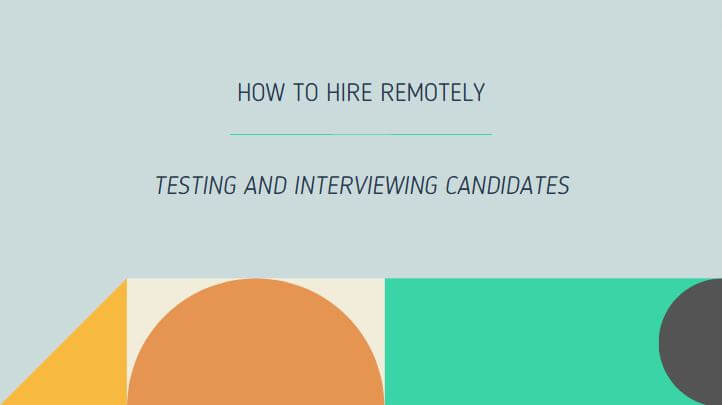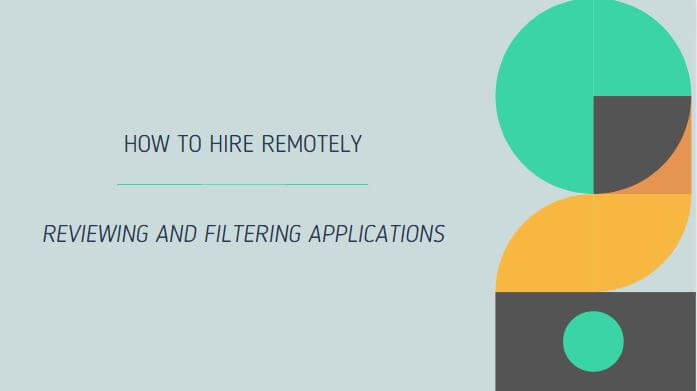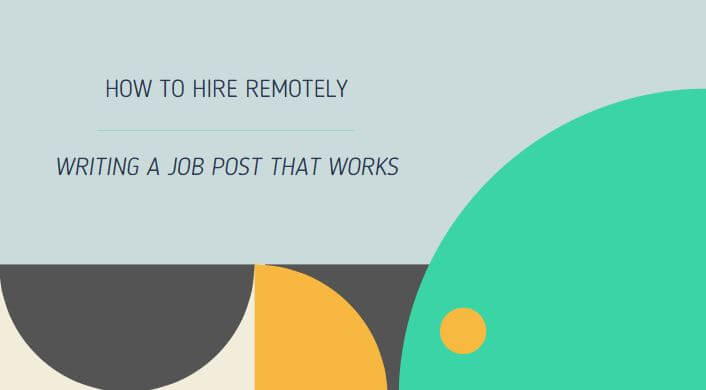- Intro
- Part 1 – Do You Need to Hire At All?
- Part 2 – Writing a Job Post That Works
- Part 3 – Reviewing and Filtering Applications
- Part 4 – Testing and Interviewing Candidates
- Part 5 – Review: Choosing the One
Testing is a key phase in the hiring process. This is where you get to see how potential candidates handle tasks that are similar to the work they’ll be doing for you if they are successful in getting the role.
In my opinion, all tests should always be paid. Offering to pay for their time as part of the application process shows a level of intent and commitment
Asking people to do test tasks that may take 2 or more hours to complete without offering payment for their time immediately sets an expectation that you expect them to work for free. Not the expectation you want to be setting. Especially for the sake of a small amount of money for a handful of candidates.
Keep the testing process simple and aim for tests that will take 1-2 hours and offer to pay 2 hours at a good hourly rate.
For Virtual Assistant/Executive Assistant/Social Media/Customer Support type roles, this means up to $30. For Developers, this might be up to $100 in total for the test.
You decide what’s reasonable. Just don’t be cheap at this stage.
The objective of the testing phase is to get evidence of their skills, see how they communicate and get a good feeling about their abilities to do what you need.
Your tests should be representative of the work you want them to do.
Here are some examples of test tasks to give you a headstart:
| Role | Sample Test Task |
| Virtual Assistant |
|
| Social Media |
|
| Marketing |
|
| Developer |
|
| Content writer |
|
| Project manager |
|
Make sure to write a very clear brief for the test (unless you want to test their ability to ask clarifying questions) and remember not to assume knowledge.
I recommend including 1-3 tasks to take 1-2 hours in total.
To make things easy for you to review, ask for submissions in a single Google doc to cover all tasks where possible, or for links to the files created to be sent in a single email if multiple docs are required (i.e. if you have a doc and a spreadsheet task).
Make it clear that the task is paid and include the hourly rate/total you’re willing to pay.
Set a reasonable timeline to complete the tasks. Bear in mind that they may have a full-time job and commitments already so one week is reasonable.
Make sure to include your contact information and offer for them to contact you if they have any questions.
You’ll find a link to a sample Test Task Briefing Document in the Resources section below.
When candidates complete test tasks, you have the chance to analyse not just the actual work produced, but also how they communicate with you.
- Did they present their submission in an easy-to-consume format?
- Did they communicate clearly giving you all the details you requested?
- Did they set the permissions on shared files correctly? (A very common mistake)
All of these will give you a better view of their suitability to work with you.
When you’ve created your test task brief and contacted those you’re progressing with, I recommend updating your tracker sheet so you can record your thoughts and the scores from the test task submissions you’ll soon be receiving.
This helps to ensure you have everything relating to each candidate in the same place. It also makes it much easier for you to review them when you’re deciding whom to interview.
When I’m hiring I create two more columns in the tracker spreadsheet:
1 – Test Task Score
This can be as simple as Great / Good enough / Not good enough.
2 – Test Task Comments
You can use these columns to record the score and your comments about each test task submission, keeping all the key details about the candidate in one place.
You can also create an extra column to include the link to the documents they’ve submitted to you for ease of reference.
You may find that some candidates will not complete the test task. They may have got another job offer, they may not be that interested, or perhaps they can’t be bothered to do the test.
Either way, don’t worry. You only want the ones that are prepared to make the effort. If they appeared particularly strong from your earlier review, then perhaps follow up by email. Maybe they didn’t receive your brief, maybe it got caught up in Spam, or maybe something happened that meant they couldn’t meet the deadline.
In my experience, a simple follow-up to check if they received your message can often result in getting a great candidate.
If you still don’t hear back then simply update your spreadsheet to record the outcome and send them feedback that you won’t be progressing with their application further.
Before I start reviewing submissions for the test task I always try to put myself in their shoes.
They don’t know what I know.
They don’t know much about me or my company.
They may not have even spoken to me yet.
When reviewing test tasks, I’m looking for enough evidence of a candidate’s ability and attitude together with how they approached the task.
If it feels lazy and careless, then I won’t progress with them.
If it feels like they’ve made a good effort and have got most of it right/good enough with what I expected, then this is generally a sign that they have the skills and I can dig a little deeper during an interview.
If you have an instance where it’s clear they’ve made a significant effort but they did the wrong thing, then consider if maybe they just misunderstood the instructions.
If that’s the case, then I recommend not dismissing them right away. Anyone can misunderstand something and this gives you a good opportunity to discuss it with them at the interview.
When you ask how they approached the task, you can get an insight into how they think and also how they receive feedback when you gently communicate what you were expecting them to do that was different.
Being able to see how a candidate handles receiving feedback is a great indicator of how well you’ll be able to work and communicate with them.
With test tasks done, it’s time for the final stage – interviews.
If you’re like many employers, you might worry about conducting interviews.
Will they realize you’re not an experienced interviewer?
What should you ask?
How can you tell if they have the skills you need?
How can you tell if they’ll stick around long-term?
Will they be a good fit?
All of these worries and fears are entirely normal. The most important thing to remember is that a good interview should be a conversation.
The objective of an interview is to get to know the candidate, get to understand their experience and get an idea of how they use their skills to work in your role and complete the tasks or projects you need them to do.
ALWAYS do interviews over videos. No excuses, no exceptions. If they say their camera is broken, then reschedule. You MUST do this face-to-face.
Planning in advance is the key to successful interviews.
You have a lot of information about the candidate already. This is where your tracker sheet will really shine, giving you all the information about the candidate in one, easy-to-access place. Review this information ahead of the interview and use it to list out key aspects of their experience or submissions that you want to talk about with them.
I recommend using an interview scoring sheet within your tracker spreadsheet, or extra columns on the main tab to record their responses/your thoughts to the interview questions you ask. You can find an example linked within the resources section.
When doing a few interviews, especially if they’re close together, it’s very easy to forget who said what and to get confused. Making good notes is key to helping your final decision-making.
Remember, interviews can be nerve-wracking for candidates. It’s your job to put them at ease so you get the best out of them. No one can open up if they’re terrified or feel like they’re being interrogated, so I always make sure I take time at the beginning of the interview to try and help them to relax with some general getting-to-know-them chat. Anything to get them talking and feeling at ease with you before you jump into the interview questions.
I recommend you split the interview into six key sections:
1 – Break the ice
Get to know them a little bit. Where do they live? What have they been up to recently? What do they like to do in their spare time? This general chit-chat will help you get to know each other.
2 – The test task
Discuss the test task – how they thought it went and how they went about it. Give them feedback and discuss any questions or concerns you had.
3 – Scenario questions
This is where you ask them questions that will let you know how they would handle a situation. This should be where you give them realistic situations they’ll face in the role and ask them what they would do.
This can be anything from unclear requirements, challenging customers, conflicting priorities, key systems, or tools not being available when there’s a deadline to meet. Adapt these to your specific business and the situations they’ll face.
You can use pretty detailed scenarios in this section. For instance, if you were recruiting for a marketing role you might ask something like:
Your objective is to increase email signups by 50% in six months from 10,000 signups per month to 15,000 signups per month. How would you go about it?
Pay attention to their thought process as much as the specifics of what they say they would do.
Things to look out for:
- Do they ask clarifying questions?
- Do they make any assumptions clear?
- Do they take a moment to think through the scenario or do they jump straight into answering?
Much like the test tasks you gave them, they don’t have a lot of information to go on. That’s why it’s important to see how they think through a task and the stages they go through – this is how they’ll likely behave when working for you and facing a situation like this.
4 – Their experience
Dig into the experience they have and verify they truly have what you need to do the role. Don’t be afraid to ask why they did something or push for details when discussing their previous roles or projects.
If for instance, they say they have five years of experience as a Digital Marketing Manager, you might ask questions like:
What were three key achievements you made in that time?
What will you be remembered for?”
What was the hardest part of the job?
Digging deeper into their subsequent answers with clarifying questions can help you really understand how they’ve worked previously and what they’ve really done.
CVs and interview answers can often be filled with grand-sounding activities, so it can really take some effort and repeated questioning asking why to get down to the detail of what they really did… and why.
This can feel uncomfortable as an interviewer, but as you do it more and you really get down to what’s real and have better information to make your decision on who to hire.
5 – What do THEY want
Whilst the interview is often focused on making sure you’re getting what you want, you also need to make sure that you focus on them and what they want.
To help with this, I often ask questions like:
- What work do you enjoy doing the most?
- How do you handle working remotely without other people around in person?
Whilst a bit of a cliche question, asking what they want to be doing in a few years in their career still yields great insight. If they want something completely different from what you’re offering, then you need to recognize they might not be with you for the long term.
This is crucial if you’re to make the right decision for the long term as well as your needs right now.
You can find out a lot about how much they really like remote work by asking things like how they like to structure their work, where they like to work from, and what their home office/work setup is. These questions will also help you determine if the way they want to work fits in with what your role can offer them.
Ask what’s important to them when considering a new job – things like salary, paid holiday, flexibility on working hours or a variety of other things. Knowing their answer to this will help you when it comes to crafting a great offer for them if they’re The One.
6 – Their questions and next steps
Always give them the chance to ask questions and finish the interview by telling them what the next steps and timescales will be for a decision/feedback.
I always make a note of the questions they’ve asked me in my tracker sheet as when reviewing candidates I find the questions they’ve asked can be good indicators in themselves of how well they’re considering the role and what it will mean for them.
After you finish with the interviews, you should be ready for the final step of our guide – Final Review & Choosing the Perfect Candidate.









